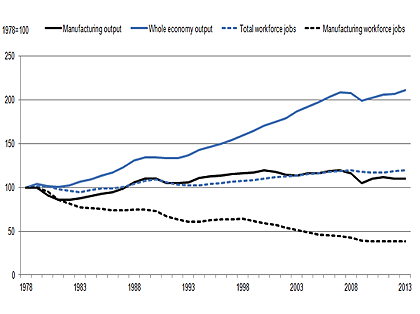UK manufacturing output is higher than in the 1970s

Total manufacturing output from the UK is now slightly higher than it was in the late 1970s, despite a dramatic fall in the number of people working in the sector, according to a new analysis by the Office for National Statistics (ONS). But the figures also chart how manufacturing has declined in size relative to other sectors, from 36% of the economy in 1948 to around 10% in 2013.
According to the ONS' chief economist, Joe Grice, productivity in the manufacturing industry has risen by around 2.8% a year since 1948, compared to 1.5% in the service industry. While only 8% of UK jobs are now in manufacturing, compared to 25% in 1978, today's workers are much better skilled and more experienced.
“The manufacturing industry has changed markedly over the past 60 years,” says Grice. “It is becoming more productive, despite a steady fall in the number of people employed and broadly stable capital stock, and the economic downturns in the 1970s, early 1990s, and notably 2008-9.
“There are several factors at work: a better quality and more skilled workforce; a shift from the production of low to high productivity goods; an improvement in the information technology base; more investment in research and development; and a more integrated global economy,” he adds. “Exporting firms generally are associated with higher productivity and foreign-owned firms in the UK generally experience higher productivity than domestic firms.”
The ONS has published its findings in a paper called The Changing Shape of UK Manufacturing. This was also the name of a London event, organised jointly by the ONS and the Department for Business, Innovation and Skills (BIS), where Grice presented the results.
The ONS research shows that:
• the number of jobs has fallen across all of the UK’s manufacturing sub-industries since 1978, with textiles being particularly hard-hit, experiencing a reduction of more than 80% between 1979 and 2013;
• the wood and paper sub-industries have been the most resilient, with job numbers falling by 40%;
• the skills and experience base has increased at a faster pace in manufacturing than most other sectors, with the exception of financial services and non-manufacturing production (including oil and gas extraction);

• between 1993 and 2013, the proportion of people aged 50 or older working in the manufacturing sector has risen from 20% to 30%, offset by a fall in the proportion of workers aged 16–29;
• the proportion of hours worked by people with no qualifications has fallen from just over 26% to 8% since 1992, with a noticeable increase in hours worked by graduates;
• all manufacturing subsectors have become more productive since 1997;
• the figures suggest a movement from the production of low-value goods to high-value goods within each sub-industry;
• productivity growth tends to be higher in firms with higher levels of ICT (information and communication technology) maturity, but the relationship is stronger in manufacturing than in the services sector; and
• manufacturers with a low ICT maturity have seen productivity fall, while those that have high ICT maturity saw a productivity growth of just over 11% a year between 2001 and 2007.
One factor that could be boosting productivity in the manufacturing sector is that some low-productivity activities that would traditionally have been classified as part of manufacturing – such as transport – have largely been contracted out and are now classified in the services sector.





